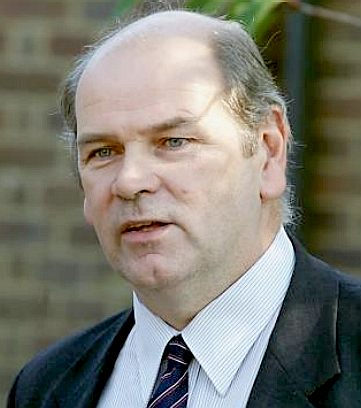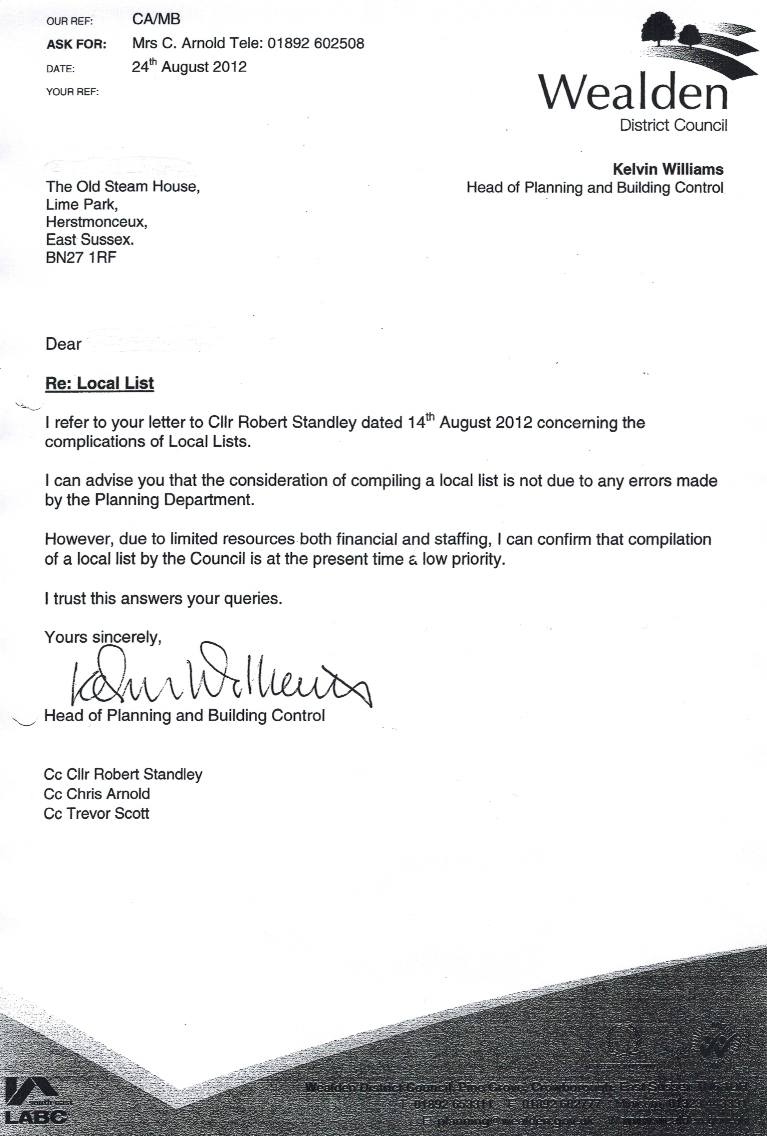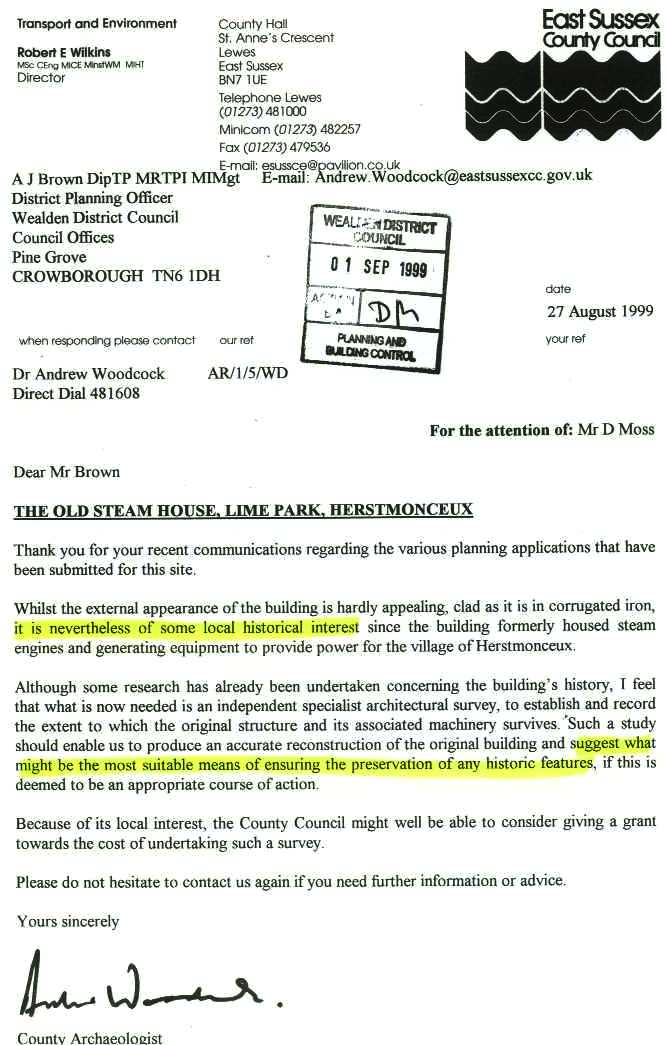F.A.O. Greg Chuter
Archaeology Section, County Archaeologist
East Sussex County Council
RECORDED FAX & POST
County Hall
St Anne’s Crescent
Lewes, BN7 1UE
2 February 2015
Dear Mr Chuter,
REF: PLANNING APPLICATION No: WD/2015/0090/MAO
We write with reference to the above application and the Reports from the applicant’s agents as to archaeology. We note that you have written to Wealden District Council on the owner’s previous application, but that some issues were not fully addressed – and these we should like to canvass with ESCC, for your views should you consider that the agencies concerned with tourism, conservation and the economy might see things from a more informed perspective, especially concerning national policy making.
Our concern here is that the application has far wider implications than everyone seems to be saying locally, where the impact on adjacent buildings of historic interest have not been addressed, and where such duty rests with the applicant – concerning listed and non-listed buildings. The applicant’s agents have not, so far, sought the views of the DCMS or English Heritage.
NATIONAL PLANNING POLICY FRAMEWORK (NPPF)
According to our NPPF at Section 12, paragraph 126, there is a requirement to have a positive strategy for the conservation and enjoyment of historic buildings. This enjoyment flows from public access and includes countryside views that in this case will be lost with the housing plan proposed.
BATTERSEA POWER STATION
In the case of Battersea Power
Station, the generating building is the main feature in a planning development that celebrates the evidence of man’s transition and progression from candles and gas lighting into the age of electricity.
Not only does the Battersea development make provision for access to the building by the public, but the design cantered on the subject structure is sure to increase tourism. This is because the UK is unique in having three rare examples to demonstrate progression from private generation (Batemans) through rural generation (Herstmonceux) to city generation at Battersea. Whereas the proposed development in the field adjacent to Herstmonceux Generating Works, will swamp the building and forever bury it in a housing estate, in unsympathetic manner. In other words, Herstmonceux Generating Works is receiving the exact opposite treatment to Battersea Power Station.
You can see photographs of the views that we believe should be conserved for the common good, access and tourism, here:
Cherry
Mortgages
Tourism_Versus_Houses_Herstmonceux_Loss_Historic_Views_Department_Culture_Media_Sport
RAMBLERS and ACCESS to the COUNTRYSIDE
Should the development proceed at shown, walkers will never know about the only surviving generating building in Europe that powered a whole village. They will walk straight past without seeing the two buildings together in one panorama. When we say walkers that includes archaeology students and tourists interested in the development of modern civilisation.
TOURISM – DEPARTMENT of CULTURE MEDIA & SPORT
Tourism is a major source of revenue for the UK with revenues on the increase because as a nation we have many interesting landmarks. We note from recent press releases that this increase is because of travel to the countryside for the appreciation of historic buildings in a relatively unspoiled setting.
With Battersea Power Station and Rudyard Kipling’s home and windmills, such as that at Windmill Hill already generating significant income as tourist attractions, it is likely that as word spreads of the juxtaposition of these attractions with the first village in the world to have loaves baked by electricity, from flour ground by a local windmill, that such an interesting association will not be lost on tour operators.
At the time of writing the view from the northern end of the field, while standing on the public footpaths, is clear across to the windmill and to the generating buildings in Lime Park. The proposed location of houses will obscure these views.
This application should not be taken in isolation. Heritage assets are irreplaceable in terms of long-term revenues from tourism, where a housing development is a short-term economic matter that can be accommodated elsewhere.
Where PPG16 (we know replaced by the NPPF, but useful in terms of consultation process) says that a council should refer an application to the County Archaeologist, and then English Heritage if there are national considerations, or if this is outside of your field of expertise, we are inviting you to apply the same logic by way of considering seeking the views of both English Heritage and the DCMS.
With the above in mind, we have copied in the Rt Hon Sajid Javid MP and the Rt Hon Helen Grant MP on this correspondence that they might have advance notice of the issues and should their departments be consulted.
NATIONAL PLANNING POLICY FRAMEWORK
Paragraph 128 of the NPPF requires an applicant to describe the significance of any historic building affected. Could we therefore ask if this requirement has been addressed fully in the context of tourism? Where it appears to us that this is not the case, could we suggest that now is the time to investigate the issues, such that a landmark tragedy is averted and an undesirable precedent created.
Paragraphs 129 to 141 of the NPPF further spells out how Paragraph 128 should be handled – and we look forward to receiving your proposals or recommendations such that the applicant/application might comply with these sections.
The visual appraisal carried out by the applicant’s agents, Barton Willmore LLP, of Soho Square, London, does not take into account the above observations as to tourism and access to the site, and incorrectly says that Herstmonceux Generating Works is contained within Lime Park. The photographs cited in the web link given above challenge that statement.
The view currently enjoyed by walkers along the Jubilee Walk will be lost, not mentioned by the applicant in some 109 pages of what it appears a ploy to play down an important local building of considerable stature in a national and international context – with reference to other historic electricity buildings, many of which are seen on the Edison technology Centre website. (See reference link below.)
The only other examples of such a building generating DC electricity in the world are in Miesbach, Bavaria, Germany (for a waterfall display), and Appleton, Wisconsin, USA (hydroelectric). All the other sites, such a Lauffen, are AC generation, making Herstmonceux an incredibly important site in a world context, and that in turn makes the power cable to the village somewhat interesting.
At the moment, walkers cannot fail to see the juxtaposition of the first village in England to have electricity in sufficient quantities that baking of loaves was an advertised marketing feature. There is a famous photograph of a horse drawn wagon advertising that the bakery in Herstmonceux is powered by electricity.
The development of this village is already established by the windmill at Windmill Hill, where flour was ground for the bakery - that was powered by electricity for Lime Park. The Jubilee Walk is itself of local and possibly national importance, as a recognised walk frequented by many Rambling groups.
This ought to have been a conservation area, as mooted by Wealden’s planning officer, Marina Brigginshaw, in 2014 at a public meeting held at the village school, and probably would have been one, if the council concerned was more alert to conservation issues and consulted with the DCMS or English Heritage routinely, rather than as convenient.
This may not be negligence on the part of Wealden, but is surely reckless abandonment of their duty to protect heritage assets, and potential endangerment of a heritage asset.
The manner in which the applicant's have sought to mitigate these facts, is seen at paragraphs 2.15 to 2.18 of their rather lengthy document. The fact that Wealden has no Local List, is a potential (contributory) problem for developers looking for potential limitations, but, in this case the onus was on the developer to seek redress from the County Archaeologist and of course, English Heritage, where the Monument is on their At Risk register.
The developers knew of Herstmonceux Museum, where they visited the site on two occasions and spoke with the curator, who made it plain in a conversation with them on the subject, to include mention of a (potentially ancient) right of way for coal deliveries to the old generating buildings. The Land Registry is sure to have copies of the Deeds and Covenants to confirm.
Likewise, the desk based archaeology report by Sally Dicks BA MIfA, as approved by Duncan Hawkins BA (Hons) MSc FSA MIfA (November 2014), takes no account of the existence of Herstmonceux Museum or the potential revenue loss from tourists, and for that reason fails to address that loss of access and visual enjoyment by the public, where that is of paramount importance according to NFFP, Section 12, from paragraphs 126 to 141. The report is thus defective in being silent.
CGMS CONSULTING Fiona Williams and Jason Clemons - The view that will be destroyed is shown in pictures numbered 19-21 and 34. Contrary to the conclusion as to inter-visibility (@ 3.4), Herstmonceux Museum is and has been for many years more of an attraction to walkers and locals, and is not particularly visible from within Lime Park, being tucked into one corner and bounded by shielding trees. Indeed, there is no public access via Lime Park, it being a private road.
With the above in mind and that there is a duty to maintain access to and enjoyment of historic buildings for the public, the views expressed by the CGMS are not accepted as taking into account the intrinsic positioning with respect to the village and the function - that will be hidden if the proposed development takes place. The worst section of housing in this regard is the centre quadrant, defined as being in between the two footpaths shown at 4.1 of the applicant's Heritage Statement.
It seems to us that this is more properly a subject for English Heritage and the department for Culture Media and Sport, both of which agencies have been left out of the official consultation process.
RAF HERSTMONCEUX
The building is not only a monument to the early electricity generating industry, it is also RAF Herstmonceux, from when it was used in World War Two as a hospital for wounded airmen, a radio outpost and bomb shelter. Lime house was used to billet RAF officers at the same time and Lime Cross recreation ground was the prisoner of war camp where Italian prisoners were held during hostilities. This important fact also comes under the heading of Industrial Archaeology should also form part of the deliberations concerning heritage.
UNDERGROUND SUPPLY CABLE
There is a cable that it is reasonable to assume runs across the field to the village and there is a Deed entry for a right of way from the proposed access to the A271 in a straight line with Herstmonceux Museum. We wonder if the underground cable should be protected, and if the right of way should also be preserved?
ENGLISH HERITAGE
We would be grateful if you would raise the appropriate heritage issues with Simon Thurley and Chris Smith at English Heritage. We have copied Mr Smith and Thurley in on this letter such that they are aware of the issues on a broad brush basis in advance.
SECRETARY OF STATE FOR PLANNING
Given that so much has not been addressed in the present application, it is our opinion that the objectives of the state, insofar as the provision of affordable housing in a manner that is sustainable, has not been met, or is questionable. We see this as a matter of public concern in the setting of an undesirable precedent, the case handling of which policy makers may wish to review by calling in the application.
We have thus copied the Rt Hon Eric Pickles MP in on this letter, such that he is aware of the application and the potential to undermine government policies.
WINDFALL TAX AGAINST OVEREXPANSION
The 70 houses will not come within the government allocation for Herstmonceux village, thus when other applicants seek to take advantage of the “allocation” and are then granted planning consents, this will have the effect of artificially increasing the size of the village by 140 houses, rather than the 70 house expansion that the SOS requires, doubling expansion.
Taken at local level, that is a local problem, but when you realise that this will be going on nationally, we will have a glut of expensive houses that distances local people more and more. These empty houses will though attract benefits applications in a likely carve up into lodgings, or for families coming from Europe, attracted by the availability of houses that local people cannot aspire to.
In such circumstances, would it be appropriate to levy a tax against windfall profits to offset benefit payments?
SCHOOL PLACES
The local school is full to capacity. Where then will the children from this development be educated? This might not be a heritage issue, but the topic is not catered for.
DRAINAGE & LAND SLIDE
The subject field is waterlogged, presenting a drainage problem, without the additional loads from a crowded development. We want to know if landslide is possible and who would pay in the event of such an incident? Does this present an unacceptable risk to the heritage asset and how might the applicant prevent hydraulic build up and geographical slippage?
We would appreciate your observation as to the above, and could you please acknowledge safe receipt of this letter at your earliest convenience.
Yours sincerely,
Max Energy Ltd (Trustee)
for Lime Park Heritage Trust
c.c. Rt Hon Eric Pickles MP Sec State Planning
Rt Hon Sajid Javid MP Sec State DCMS
Rt Hon Helen Grant MP Minister Tourism
Simon Thurley CEO English Heritage
Chris Smith Dir National Planing & Conservation
Cllr Keith Glazier (ESCC Leader)
Cllr Robert Standley (WDC Leader)
Kelvin Williams (WDC planning head)
BBC, Guardian, Independent, Times
REFERENCES
http://en.wikipedia.org/wiki/Miesbach%E2%80%93Munich_Power_Transmission
http://www.cherrymortgages.com/historic_britain/world_electrification_power_grids_history_edison_thomas.htm
http://www.focol.org/hearthstone/ourhistory.html
http://www.edisontechcenter.org/LauffenFrankfurt.html
|




